Ultimate Visitor’s Guide To Explore Qutub Shahi Tombs In 2026
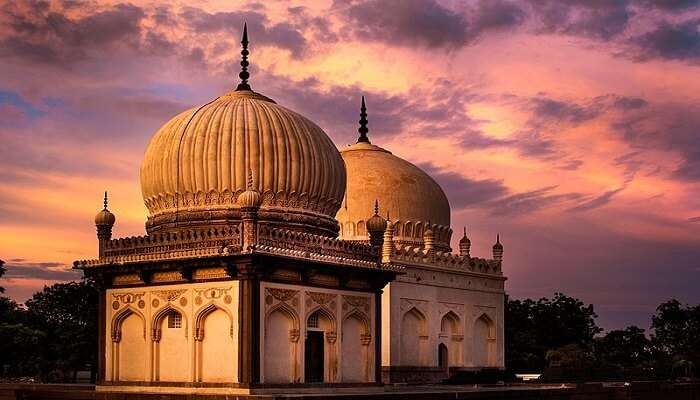
Situated in Hyderabad, Telangana—India—the Qutub Shahi Tombs present one of the most marvelous architectural structures and show the rich heritage left by history. These lie amidst landscaped gardens, making it one big necropolis for seven quite famous rulers of the Qutub Shahi dynasty. The intermingled Persian and Indian kinds of architecture in each intricate tomb reflect its great strategically organized setting and the high artistic bent of mind prevalent during the late 16th to early 17th centuries. Apart from the intrinsic, thinly-cut domes, wonderful masonry, and subdued surroundings, visitors to the Qutub Shahi Tombs also immerse themselves in the history of the royal family of Hyderabad, which can rightly be termed a peep into the socio-cultural canvas of the city.
Qutub Shahi Tombs’s History
Steeped in a rich history, the Qutub Shahi Tombs are a paradise for history buffs. Below is an overview of this amazing tourist destination.
1. Construction And Architectural Importance
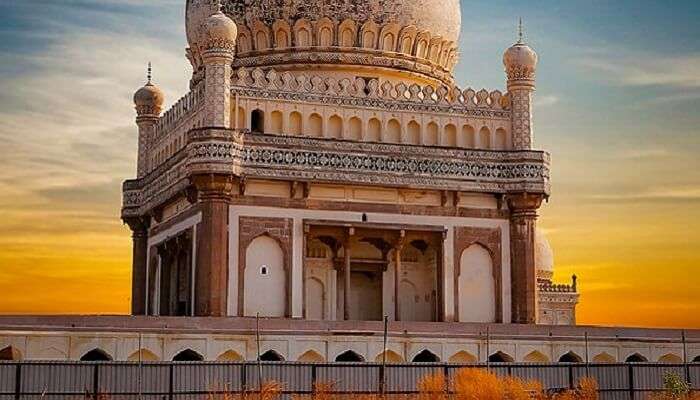
Qutub Shahi Tombs is located in Hyderabad, Telangana, India. Their history dates back to when the Qutb Shahi Dynasty ruled this region from 1518 to 1687. These tombs were built spanning several decades—primarily during the 16th and 17th centuries—as the final resting places for rulers and other nobility of that dynasty. The style of the tombs combines Persian, Indian, and Deccani architectural styles in form, showing the cultural synthesis prevalent at that time. Each single tomb represents a masterpiece of stone craft with elegant arches and domes carved out intricately and exquisitely finished with stucco work.
Sultan Quli Qutb-ul-Mulk, the founding ruler, initiated the mausoleum in this sprawling complex of tombs. Further ruling agendas expanded the site and added more tombs with embellishments, culminating in a graveyard that contains the tombs of seven Qutub Shahi rulers, contending members of their families, and trusted courtiers. Notable among the structures in this compound are the onion dome-shaped tomb of Mohammed Quli Qutb Shah, with a finely wrought marble lattice, and the magnificent mausoleum of Sultan Quli Quli Qutb-ul-Mulk, which headed all the structures within the compound.
Tip: While walking through the Qutub Shahi Tombs, trace minute details of the streamlined arches, delicate stucco work, and ornate domes. Every mausoleum speaks for itself as a great blend of Persian, Indian, and Deccani styles alike—styles that speak of cultural fusion so very typical during the reign of this dynasty. Take your time to grasp the finesse and symbolism behind each of the stone carvings and decorative elements within them, personifying the heightened artistic skills and imperial sponsorships of the Qutb Shahi rulers.
Also Read: Hotels Near Hussain Sagar
2. Historical And Cultural Relevance
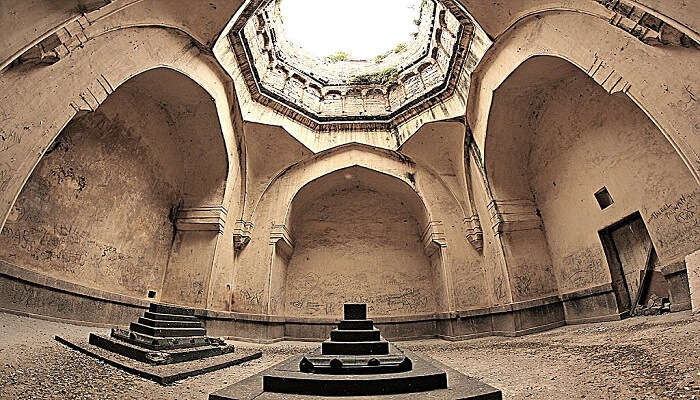
Beyond their architectural glory, the Qutub Shahi Tombs are a great historical and cultural heritage for Hyderabad and a whole for the Deccan. These tombs became sacrosanct resting places and stood for the dynastic pride and achievements of the ruling Qutub Shahi. In the case of each one of these, art, literature, and architecture received patronage during their reign and contributed to the rich flowering cultural landscape that existed at that time.
This grand ensemble is located at a well-strategically located place near the historic Golconda Fort, thereby underlining the importance of this site in governance and cultural life according to the Qutub Shahi dynasty. The tombs themselves testify to events that have covered centuries: the creation and extinction of dynasties, the marvellous cross-cultural exchange providing cultural identity to Hyderabad, and the architectural growth. Today, the Qutub Shahi Tombs is a UNESCO World Heritage site with outstanding universal value for contributing to world heritage. This area attracts hundreds of visitors and historians from all over the world who come to relive the rich history hidden within these architectural marvels.
Tip: It is easy to bring out the historical importance of this place with a visit to the Qutub Shahi Tombs, aided by guided commentary or self-guided audio aids on site. These aids may help decipher the life of the rulers, the evolution of architectural art with time, and cultural influences at work in designing the tombs. Understanding the strategic placing of the tombs about the Golconda Fort and their relationship with Hyderabad’s role in the cultural-political scene facilitates more appreciation for its UNESCO World Heritage status and its lasting heritage within Deccan history.
Architectural Features
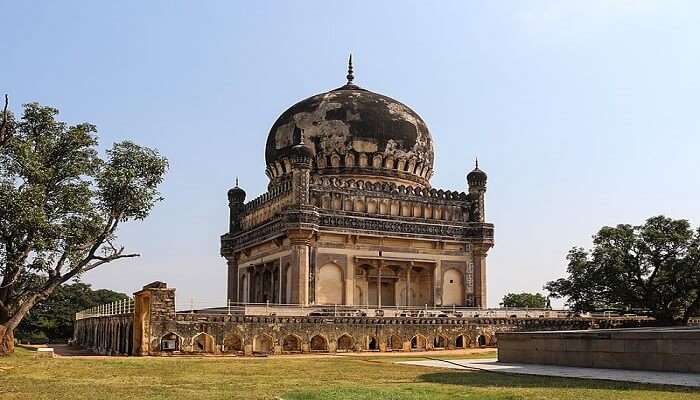
Qutb Shahi Tombs’s architecture is an amalgam of Persian, Indian, and Deccani styles that make up for the cultural synthesis that took place within the Deccan during the 16th and 17th centuries. Each tomb in this compound rejoices in being an epitome of stone craftsmanship, where intricate carvings, graceful arches, and elaborate domes have become hallmarks of the structure. Prominent buildings are primarily constructed with locally sourced granite, from which flair artists created ornate facades and intriguing patterns.
Noteworthy among its architectural features are:
- Domes: The domes are the main features of the tombs. They are bulbous or onion-shaped, often crowned at the top with finials, and surmounted by kleshas or decorative water pots, symbolizing prosperity and spiritual importance.
- Arches and Columns: The structures are supported by slender columns and have elegant arches, which combine the ideas of Islamic and Hindu architectural styles.
- Ornamental Details: Intricate stucco work, detailed latticework windows, or jalis, and delicate plaster carvings enhance the interiors and exteriors of the tombs, testifying to the skill and attention to minute details by the artisans.
Tip: On visiting the Qutub Shahi Tombs, watch the intricate architecture, including arches, ornate domes, and carved stucco, for a closer view. These elements bring out a fusion of styles—Persian, Indian, and Deccani—that typifies cultural syncretism during this period. Notice the use of symbolism in the designs with kleshas at the domes and the intricate jali, or lattice screen, details that have much to say about spiritual beliefs and cultural mores of the Qutub Shahi rules.
Related Post: Resorts In Medak
Evolution And Influence
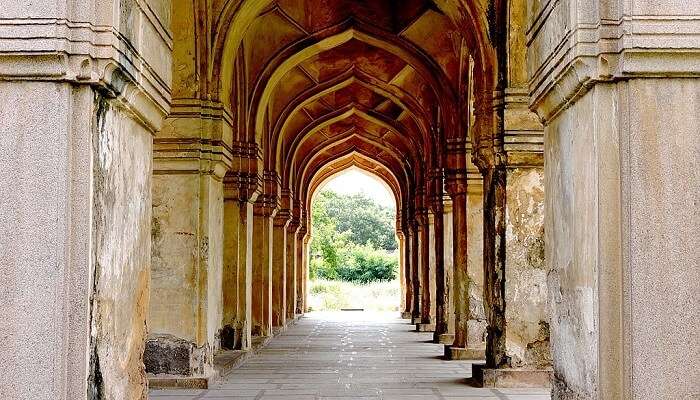
The Qutub Shahi Tombs evolved over time under the patronage of successive rulers of the Qutub Shahi dynasty, all of whom contributed to the complex’s architectural richness and stylistic diversity. Whereas the first tombs are smaller in design and have simple architectural elements, the latter structures, like the tomb of Mohammed Quli Qutb Shah, reveal greater sophistication and grandeur.
Starting from Hyderabad, the Qutub Shahi Tombs architectural influence goes much further, influencing new succeeding styles in Deccan and beyond. The fusion of Persian, Indian, and local Deccani elements gave birth to an independent architectural identity that continued evolving under succeeding dynasties—the Mughals and later Nizams of Hyderabad. Today, these tombs are featured in the UNESCO World Heritage list, not just as incredible architectural feats but also as immense historical and cultural values in the cultural heritage of architecture in India.
Tip: one can appreciate the evolutionary architecture of Qutub Shahi Tombs chronologically, from the simple, early tombs to the more elaborate later ones. Note how architectural form and artistic expression change from one ruler to another with changes in fashion and cultural influence. This enriches an appreciation of their UNESCO World Heritage status and lasting legacy in Indian architectural history.
Qutub Shahi Tombs Timings
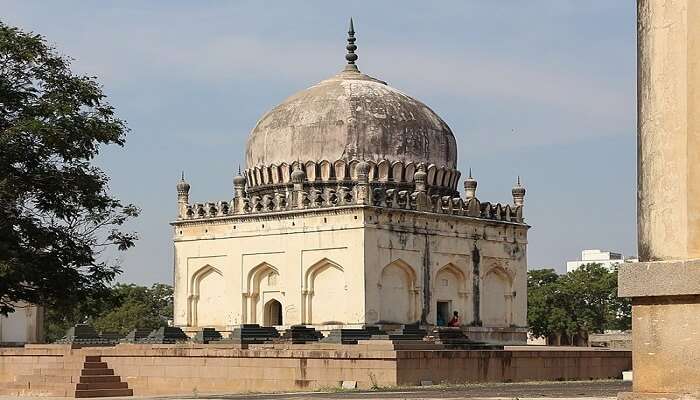
The Qutub Shahi Tombs, located in Hyderabad, Telangana, are open to visitors from 9.30 AM to 4.30 PM daily. Architectural and historical sublimity is epitomized in these magnificent tombs, built over several decades from the late sixteenth to early seventeenth centuries in a mixture of Persian and Indian styles, landscaped among picturesque gardens.
Every tomb, dedicated to one of the seven rulers of the Qutub Shahi dynasty, has intricate stonework, ornate domes, and serene surroundings that beckon one to explore and contemplate. Be it the exterior’s craftsmanship or stroll in the peaceful gardens, visitors can get completely soaked in the rich heritage of culture and the royal legacy left behind by Hyderabad’s past.
You May Also Like To Read: Nehru Zoological Park
It showcases timeless beauty and historical grandeur—the Qutub Shahi Tombs in Hyderabad, classed as a UNESCO World Heritage site, epitomize India’s rich cultural heritage. Laid-back gardens, intricate architecture, and some fascinating historical anecdotes all come together in the royal mausoleums that hold in their eternal sleep the remains of seven rulers of the Qutub Shahi dynasty. Plan your visit to the architectural and historical greatness that epitomizes the legacy of Hyderabad’s royal past. So why wait? Plan your trip to Hyderabad today!
For our editorial codes of conduct and copyright disclaimer, please click here.
Cover Image Credit: Alaka123 for Wikipedia
Frequently Asked Questions About Qutub Shahi Tombs
To what extent are the Qutub Shahi Tombs historically important?
Architecturally representative of a fusion of Persian, Indian, and Deccani faces, the Qutub Shahi Tombs are the final resting place of seven emperors of the dynasty that ruled over the Deccan during the 16th and 17th centuries. At the same time, they epitomize the rich culture, in particular, of Hyderabad.
What are the notable architectural features of the Qutub Shahi Tombs?
The architectural features of these tombs are the graceful domes, intricate stonework, developed arches, and lacy canopies, which enhance the beauty of the tombs. Each one of them has developed bands and friezes of plaster carving and filigree bordering, rich in artistic taste of the period and a composite architectural style.
How many tombs make up the Qutub Shahi Tombs complex?
In reality, there are seven grand tombs, all belonging to the Qutub Shahi kings themselves, along with several other smaller tombs and graves belonging to other personalities of the family as well as the court.
When to visit Qutub Shahi Tombs?
The visiting time to the Qutub Shahi Tombs is open all through the year. From October to March, the walking days being cooler, the weather is most suitable for going around the open courtyard and the garden area around the tombs.
Are there any guided tours to this site?
Yes, at the Qutub Shahi Tombs, there are guided tours to help the visitors know about the history, view the architecture, and soak in the cultural importance this place beholds. Local guides provide information on the history of each tomb, its rulers, and the methods of achieving the level of decoration attained.
People Also Read:
Ibbankatuwa Megalithic Tombs Paigah Tombs Mariam’s Tomb

With a passion for exploring and travelling to the roads long forgotten, experience the world through enthralling stories and adventures. Join me as I share my experiences at some of the world’s most popular tourist destinations and quench that pestering curiosity with something exciting!











